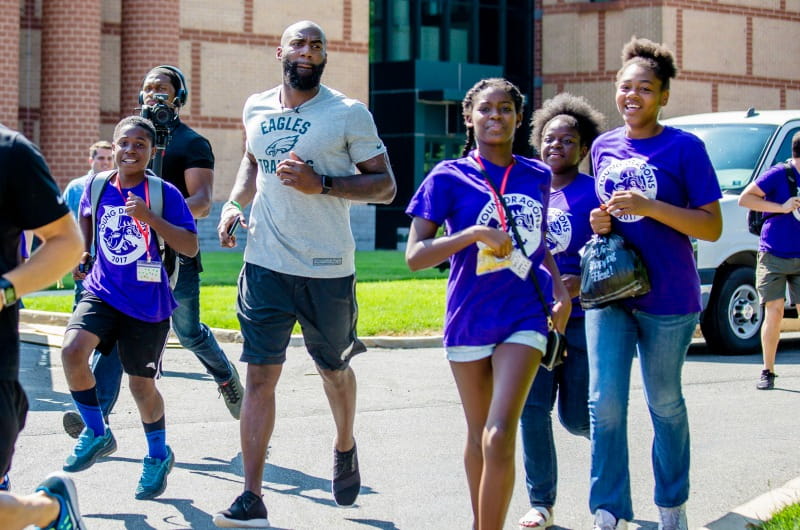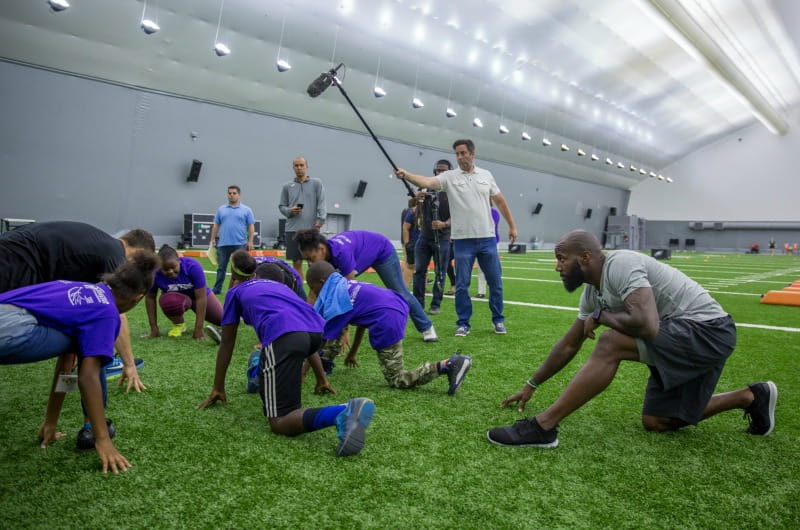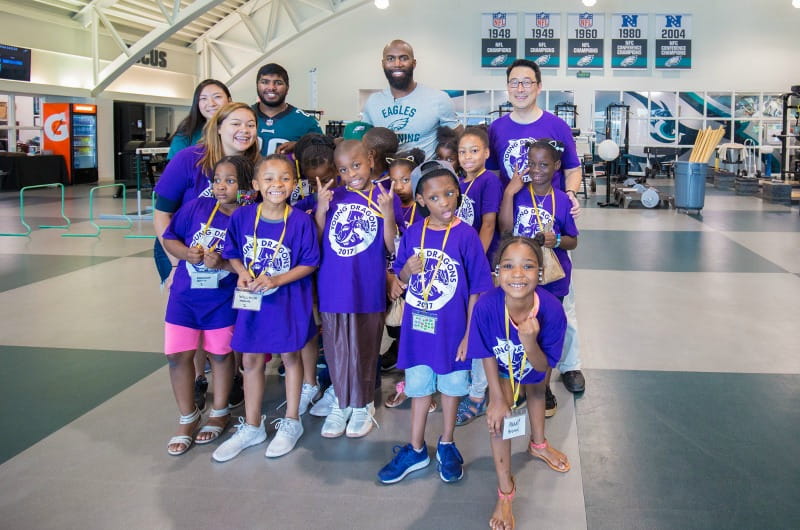Young Dragons Take Flight With an Eagle at 'STEAM' Camp
 By Ben Seal
By Ben Seal

- Drexel Selects New, World-Class Life Sciences Building at 3201 Cuthbert Street for Medical Research Operations
- Dragons Deliver: Drexel’s Annual Holiday Drives Support Military and Local Families
- Heard Around Campus — December 2025
- Celebrating a Year of Milestones, Achievements and Transformative Change

Philadelphia Eagles safety Malcolm Jenkins runs around the NovaCare Complex with a group of Young Dragons who visited for a day to learn what goes on behind the scenes at the training facility.
One by one, the kids dropped to the turf inside the Philadelphia Eagles’ domed training facility, falling in line with head strength coach Josh Hingst as he put them through the same stretches the team uses to prepare for games. They ran through the paces with a bit of added motivation supplied by the presence of Malcolm Jenkins, the Eagles’ Pro Bowl safety, who joined in himself, stretching out for a busy day touring nearly 50 members of the Young Dragons Summer STEAM camp around the facility.
The visit to the NovaCare Complex in South Philadelphia on July 21 came on the final day of a two-week run of activities focused on STEAM — science, technology, engineering, art and math — for fourth through eighth graders at Drexel University’s ExCITe Center and Dornsife Center for Neighborhood Partnerships as part of a summer camp organized by the Lindy Center for Civic Engagement and the Pennsylvania 21st Century Community Learning Centers. Through a partnership with the Malcolm Jenkins Foundation, the camp took a field trip to learn about the technology and health equipment the Eagles use to track movement, strength, nutrition, sleep and nearly everything else that happens on or off the football field. It was a fitting culmination for a camp all about how science, technology, engineering, the arts and math intersect in the real world.
“The whole 'STEAM' philosophy is about multidisciplinary integration,” said Youngmoo Kim, PhD, professor in the College of Engineering and director of the ExCITe Center, who led the field trip. “Science doesn’t tell the whole story. It tells a lot — I’m a scientist and engineer myself — but science education in general focuses on those things where we’re trying to find the right answer to everything, whereas in arts and design, there isn’t necessarily a right answer. So we try to highlight those connections.”

At the NovaCare Complex, those connections were everywhere. In the weight room, the Young Dragons watched Jenkins — “an incredible advocate” for young people, Kim said — practice his vertical leap on equipment that measures every aspect of a jump. They learned about force plates and dynamometers used to measure power. On the practice field, they learned how radio frequency identification tags (RFIDs) help the team track players’ exact movements. In another section of the facility, they learned about heart rate monitors, sleep hygiene and the food that fuels world-class athletes.
Decked out in purple Young Dragons t-shirts, the students bounded around the training complex all morning, excitedly taking in the experience as if they were Eagles themselves. During a brief introduction from Jenkins inside the team’s meeting room, he told students they were getting the VIP treatment.
“You’re in my seat!” he said to one student before showing the camp how he and his teammates train.
The day’s lessons were right in line with the activities the students — all residents of the West Philadelphia Promise Zone attending at no cost — experienced throughout the 'STEAM' program. During these two weeks (part of the six-week summer camp at Dornsife), the Young Dragons used dance and body movement lessons to explore aspects of physics and algorithms. Visual arts activities taught them about geometry and the visualization of data and information. Using music technology, they learned about circuits and electronics. There was even a game design activity that opened the students up to computer coding.
The visit to the Eagles’ facility touched on many of the same ideas, all wrapped up in the functions of a team that surely attracts a bit of attention on Sundays from many of the Young Dragons in attendance.
“Tapping into that interest makes a great impact in terms of what they think science is, what they think math is, and that picture isn’t always painted so well in schools,” said Dave Rosen, a PhD candidate in psychology in the College of Arts and Sciences and the head academic instructor for the camp.

By providing students with a “sensory, visceral experience” and moving beyond the abstract, the camp aimed to connect in a deeper way and make a more lasting impact, Rosen said. After starting as a much smaller pilot program last year, the Young Dragons camp, which also partners with the Lindy Center for Civic Engagement and the 21st Century Community Learning Centers program, managed to scale up and still deliver an exciting educational experience — and the students were ready to soak it up.
“This is a really great group of kids,” said Rosen. “These kids are super receptive, they’ve been engaged each day. They love coming to the ExCITe Center. They see where video games are being made, where music research happens, where fashion research happens, where robotics research happens, and they love it. It’s been a great two weeks.”
To Kim, the two weeks of activities — and the trip to meet Jenkins and explore the Eagles’ facility — were much more than a fun summer distraction.
“It’s not really about giving them a summer camp opportunity,” said Kim. “It’s about trying to open up pathways to the future. You’d be hard-pressed to find a sixth-grade classroom that’s trying to do things combining dance and physics, but we see STEAM and that sort of integration as the pathway to the future.”
Drexel News is produced by
University Marketing and Communications.